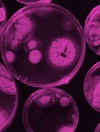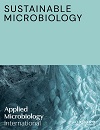Latest Publications
Gladiolin produced by pathogenic Burkholderia synergizes with amphotericin B through membrane lipid rearrangements
 Claudia Simm, Tzong-Hsien Lee, Harshini Weerasinghe, Dean Walsh, Ioanna T Nakou, Madhu Shankar, Wai Chung Tse, Rebecca Inman, Robert J Mulder, Freya Harrison, Marie-Isabel Aguilar, Gregory L Challis, Ana Traven
Claudia Simm, Tzong-Hsien Lee, Harshini Weerasinghe, Dean Walsh, Ioanna T Nakou, Madhu Shankar, Wai Chung Tse, Rebecca Inman, Robert J Mulder, Freya Harrison, Marie-Isabel Aguilar, Gregory L Challis, Ana Traven
Amphotericin B (AmpB) is an effective but toxic antifungal drug.. AmpB disrupts fungal membranes by two proposed mechanisms: ergosterol sequestration from the membrane and pore formation. Whether these two mechanisms operate in conjunction and how they could be potentiated remains to be fully understood. Here, we report that gladiolin, a polyketide antibiotic produced by Burkholderia gladioli, is a strong potentiator of AmpB and acts synergistically against Cryptococcus and Candida species, including drug-resistant C. auris. Gladiolin also synergizes with AmpB against drug-resistant fungal biofilms, while exerting no mammalian cytotoxicity.. Collectively, our findings shed light on AmpB’s mechanism of action and characterize gladiolin as an AmpB potentiator, showing an antifungal mechanism distinct from its proposed antibiotic activity. We shed light on the synergistic mechanism at the membrane, and provide insights into potentiation strategies to improve AmpB’s activity/toxicity relationship.
Membrane staining and phospholipid tracking in Pseudomonas aeruginosa PAO1 using the phosphatidylcholine mimic propargyl-choline
 Chris L B Graham, Jack Bryant, David I Roper, Manuel Banzhaf
Chris L B Graham, Jack Bryant, David I Roper, Manuel Banzhaf
Here we describe a method for in vivo phospholipid labelling by fluorescent imaging in Pseudomonas aeruginosa using a phosphatidylcholine (PC) mimic, “propargyl-choline”(PCho). This click-chemistry liable headgroup mimic is visible by microscopy and allows the covalent labelling of lipids. Fluorescence of the cell membranes, visible in heterogenous patches, is dependent on PCho concentration and is localised in the membrane fraction of cells, demonstrating that it is suitable for membrane labelling and cell imaging.
Isolation and Characterisation of Novel Lytic Bacteriophages for Therapeutic Applications in Biofilm-Associated Prosthetic Joint Infections
 Nathan J. Burton, Luís D R. Melo, Michaël F D. Tadesse, Bethany Pearce, Evangelos Vryonis, Antonia P. Sagona
Nathan J. Burton, Luís D R. Melo, Michaël F D. Tadesse, Bethany Pearce, Evangelos Vryonis, Antonia P. Sagona
In this study, we produced a cocktail of novel bacteriophages and assessed their viability to eradicate nosocomial staphylococcal biofilms. Here, we used clinical isolates from prosthetic joint infections to isolate and identify four new bacteriophages from sewage effluent. These novel phages were characterized through electron microscopy and full genome sequencing. Subsequently, we combined them into a phage cocktail, which effectively re-sensitized biofilms to vancomycin and flucloxacillin. Notably, this phage cocktail demonstrated low cytotoxicity in vitro to human epithelial cells, even when used alongside antibiotic treatments. These findings highlight the potential of the phage cocktail as a tool to increase antibiotic treatment success in prosthetic joint infections.
Cutaneous leishmaniasis in British troops following jungle training in Belize: Cumulative incidence and potential risk practices
 Rawlings, Ngwa Niba, Bailey, Mark, Craig, Peter, Courtenay, Orin
Rawlings, Ngwa Niba, Bailey, Mark, Craig, Peter, Courtenay, Orin
British soldiers undergoing jungle training in Belize typically experience a relatively low risk of developing cutaneous leishmaniasis. However, an uncharacteristically large outbreak of cutaneous leishmaniasis occurred in 2022. This study aimed to determine the cumulative incidence of the disease and highlight potential shortcomings in personal protective measures to mitigate exposure to sand fly vector bites. A retrospective analysis was conducted on medical records of cutaneous leishmaniasis cases between 2005 and 2022, as well as on questionnaire responses regarding personal protective measures administered to cutaneous leishmaniasis cases in 2022. The reasons behind the unusually high numbers of cutaneous leishmaniasis cases and cumulative incidence in 2022 remain unclear, emphasising the need to improve personal protective measures provision and implement a comprehensive health education programme for troops undergoing jungle training in Belize.
Emergence of synchronised growth oscillations in filamentous fungi
 Praneet Prakash, Xue Jiang , Luke Richards, Zoe Schofield, Patrick Schafer Marco Polin, Orkun S. Soyer & Munehiro Asally
Praneet Prakash, Xue Jiang , Luke Richards, Zoe Schofield, Patrick Schafer Marco Polin, Orkun S. Soyer & Munehiro Asally
Many species of soil fungi grow in the form of branched networks that enable long-range communication and mass flow of nutrient. While there have been investigations on the branching of the fungal networks, their long-term growth dynamics in space and time is still not very well understood. In this study, we monitor the spatio-temporal growth dynamics of the plant-promoting filamentous fungus Serendipita indica for several days in a controlled environment within a microfluidic chamber. We find that S. indica cells display synchronised growth oscillations with the onset of sporulation and at a period of 3 hours. Quantifying this experimental synchronisation of oscillatory dynamics, we show that the synchronisation can be recapitulated by the nearest neighbour Kuramoto model with a millimetre-scale cell-cell coupling.
Complement-mediated killing of Escherichia coli by mechanical destabilization of the cell envelope
 Georgina Benn, Christian Bortolini, David M Roberts, Alice L B Pyne, Seamus Holden, Bart W Hoogenboom
Georgina Benn, Christian Bortolini, David M Roberts, Alice L B Pyne, Seamus Holden, Bart W Hoogenboom
Complement proteins eliminate Gram-negative bacteria in the blood via the formation of membrane attack complex (MAC) pores in the outer membrane. However, it remains unclear how outer membrane poration leads to inner membrane permeation and cell lysis. Using atomic force microscopy (AFM) on living Escherichia coli (E. coli), we probed MAC-induced changes in the cell envelope and correlated these with subsequent cell death. We conclude that bacterial cell lysis is only an indirect effect of MAC formation; outer membrane poration leads to mechanical destabilization of the cell envelope, reducing its ability to contain the turgor pressure, leading to inner membrane permeation and cell death.
